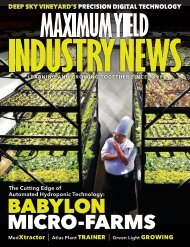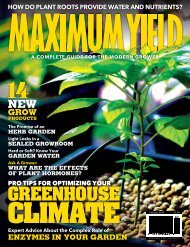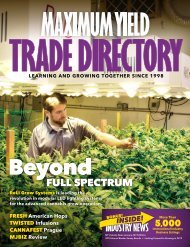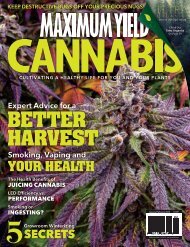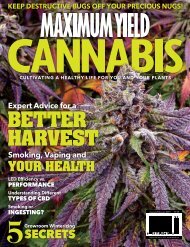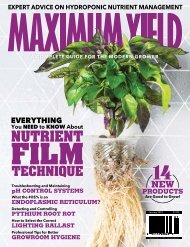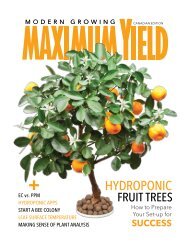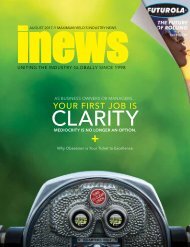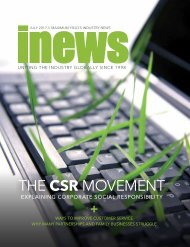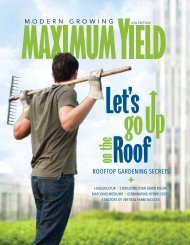Maximum Yield Modern Growing | Canadian Edition | May June 2017
In this issue of Maximum Yield, we cast a wide net to bring you the best and latest information possible to help you get started growing your own food. From the basics like cleaning your equipment to the best methods for preparing your plants to live outdoors, to more advanced topics like lighting and nutrient delivery, there is something in this issue for all levels of grower.
In this issue of Maximum Yield, we cast a wide net to bring you the best and latest information possible to help you get started growing your own food. From the basics like cleaning your equipment to the best methods for preparing your plants to live outdoors, to more advanced topics like lighting and nutrient delivery, there is something in this issue for all levels of grower.
Create successful ePaper yourself
Turn your PDF publications into a flip-book with our unique Google optimized e-Paper software.
microponics<br />
INTEGRATED FOOD PRODUCTION<br />
Integrated systems are always more<br />
than the sum of their parts. Integration,<br />
in a microfarming context, is essentially<br />
about value creation. An integrated food<br />
production system should provide for<br />
better quality, greater quantity, shorter<br />
timeframe, and lower cost.<br />
Aquaponics is the integration of fish<br />
and plants through the combination<br />
of recirculating aquaculture and<br />
hydroponics. Aquaponics is an example<br />
of integration on a small scale: the<br />
fish produce waste that is converted to<br />
plant nutrients, the plants take up the<br />
nutrients; and, in so doing, clean the<br />
water for the fish.<br />
Microponics is the integration of fish,<br />
plants, and microlivestock through<br />
the combination of recirculating<br />
aquaculture and other plant and<br />
animal production systems.<br />
We eat the fruit, vegetables, herbs,<br />
and fish from our aquaponics systems<br />
and the wastes from our kitchen go to<br />
the worms or black soldier fly larvae.<br />
The worms and larvae are then mixed<br />
with duckweed to become food for other<br />
microlivestock. In this simple model,<br />
there is no actual waste in a landfill<br />
sense. The so-called waste product of<br />
one organism becomes the feedstock<br />
for another. And the scope of integration<br />
doesn’t stop there. We can add other<br />
small livestock (like rabbits, chickens,<br />
quail, ducks, snails, and bees) and water<br />
gardening for edible plants like Chinese<br />
water chestnuts and water spinach.<br />
In this extended model of integration,<br />
we get fish, quail/chicken/duck meat<br />
and eggs, worm castings/tea, duckweed,<br />
vegetables, herbs, rabbits, skins,<br />
and honey. We also get pollination, pest<br />
control, cultivation, and weed removal.<br />
MICROPONICS ORIGINS<br />
The challenge when designing small<br />
integrated food production systems<br />
is to see every output as a resource,<br />
even waste body heat and expired<br />
carbon dioxide.<br />
When I first set out to describe a concept<br />
of small-scale integrated food production<br />
several years ago, I called it integrated<br />
backyard food production (IBFP).<br />
Like aquaponics, IBFP is a descendant<br />
of the integrated aquaculture work<br />
of the New Alchemist Institute.<br />
With its inclusion of microlivestock,<br />
however, IBFP has retained a more<br />
direct relationship with integrated<br />
aquaculture.<br />
“Integrated backyard food production”<br />
became too much of a mouthful, so<br />
in 2008, it became microponics. The<br />
name suggests its own origins—<br />
the combination of micro-farming,<br />
microlivestock, and aquaponics.<br />
When it comes to fish production,<br />
aquaponics and microponics both start<br />
off in the same place. A recirculating<br />
aquaculture system (RAS), or micro fish<br />
farm, is at the heart of both microponics<br />
and aquaponics.<br />
The connection of a plant-growing<br />
system to the RAS creates a simple<br />
aquaponic ecosystem that, because they<br />
are in the same water column, benefits<br />
both the fish and the plants.<br />
In the past 10 years or so, we’ve<br />
designed and built many aquaponics<br />
systems in which we’ve grown jade perch,<br />
barramundi, silver perch, and Murray<br />
cod. We’ve also experimented widely with<br />
hydroponic growing systems including<br />
nutrient film technique (NFT), raft culture,<br />
tray system, and satellite pots.<br />
52 grow cycle




